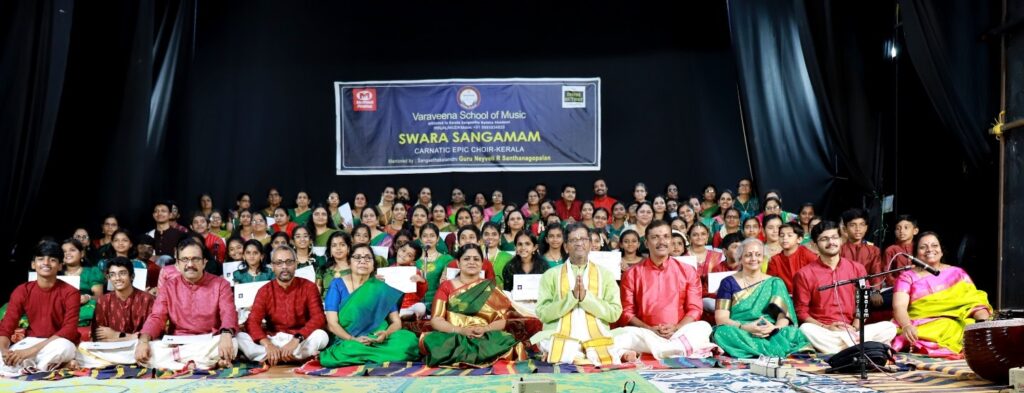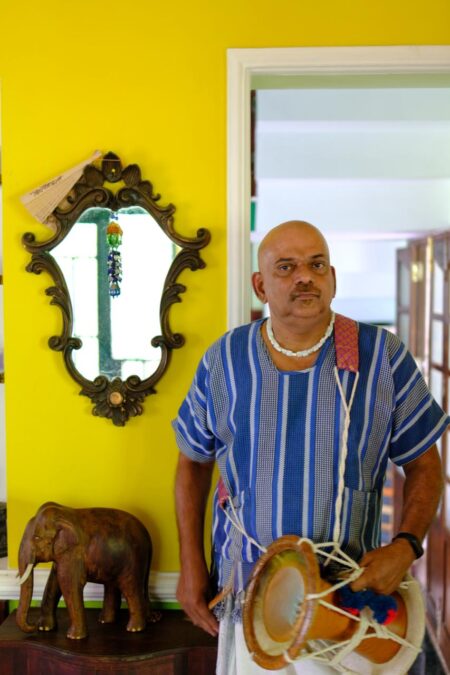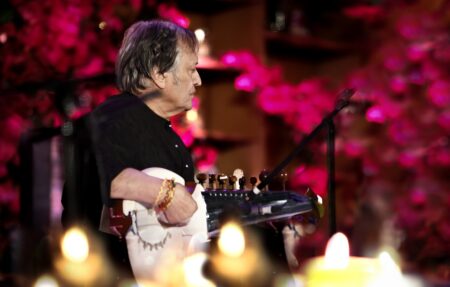Renowned musician Neyveli Santhanagopalan directed the innovative Carnatic choir performance
Congregational singing is alien to Indian classical music. Thyagaraja Pancharatna Kirtanas and bhajans are perhaps the only exceptions. But Irinjalakuda-based Varaveena School of Music made history recently by presenting a singular programme Carnatic Epic Choir directed by the veteran musician Neyveli Santhalagopalan.
Interestingly, a contingent of one hundred musicians belonging to the age group of seven to seventy sang eight select compositions, thereby proving the efficacy of group singing in Carnatic music. This novel venture was staged at the Regional Theater of Kerala Sangeetha Nataka Akademi, Thrissur before an invited audience. Each composition was received with roaring ovations.

Santhanagopalan himself directed each song standing on the stage facing the contingent, very much on the lines of a conductor of Western music.
Musical ingenuity
The group opened with Thotakashtakam, an octad of verses composed by Giri, a disciple of Adi Sankara in praise of his Guru. Thotaka being the meter in which this was composed, the disciple was known as Thotakacharya. It spoke for the musical ingenuity of Santhanagopalan that he presented the song in eight varieties of Ranjini raga – Ranjini, Karnaranjini, Janaranjini, Manoranjini, Sivaranjini, Sriranjini, Sruthiranjini and Rasikaranjini.
Pasupathipriya , a janya raga of Harikamboji and attributed to by Harikesanallur Muthayya Bhagavathar belongs to the genre of Note swaram. The number was a manifestation of the title of the programme Swara Sangamam as Santhanagopalan had divided the notes among the musicians and finally all the swaras joined together creating a marvel of choral music.
Poonthanam’s Jnanapana followed next which was rendered in the typical traditional style creating an ambience of bhakti. Kandukandangirikkum janangalle was enthralling.
A garland of Thyagaraja compositions in Desadi talams titled Desadimala followed. Select pallavis in different ragas was included in this.
After Swatithirunal’s much sought-after composition Bhogeendrasayinam, Adalaseda a Thirupugazh by Arunagiri Nathar was rendered. Santhanagopalan had scored music for the same in a ragamalika embracing Peelu, Chenjurutti and Brindavanasaranga.

The Sanskrit composition Maithrim Bhajatha of Paramachrya of Kanchi had became world famous since M S Subhulakshmi had sang it at the United Nations on October 23, 1966 on the UN day. Originally composed as a ragamalika by Vasant Desai, Santhanagopalan had retuned it in Yamuna Kalyani and Kapi.
Choice of Harivarasanam as the last number was indication enough of the propriety of the musician as it was of contemporary relevance. An inspired audience joined by clapping and singing the popular song.
Intensive training
The programme was the end result of a six-month saga of intensive training, both online and offline, the credit for which goes to Santhanagopalan as well as the music institution led by Sreevidya Varma. This was reflected by the perfect sruti alignment by the large group that had toddlers seated on the first row. The verve with which they sang out each composition following the directions given by Santhanagopalan was commendable.
Santhanagopalan proved his dexterity in this singular presentation by directing each section with the tip of his fingers. And the accompaniment artistes including Mythily Krishnan (vina) – a disciple of Santhanagopalan – Vayala Rajendran (violin), Sanoj Poongad (mridangam) contributed immensely for the success of this unique programme, the first of its kind in this country.
The presence of senior musicians, including Mathangi Sathyamoorthy, Dr. K. T. Sreeja, Ajith Namboothiri, Vidyalakshmi, and Dr. Prasanth from the Netherlands, enhanced the beauty of the renditions. As for the contingent, they represented the entire country.
The didactic description of each composition given by Sreevidya Varma added depth to the performance.





2 Comments
Very nice program. Happy to hear
A great effort Pl keep up this auspicious beginning